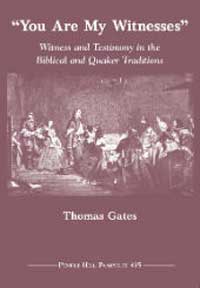You Are My Witnesses: Witness and Testimony in the Biblical and Quaker Traditions
Reviewed by Paul Buckley
April 1, 2016
 By Thomas Gates. Pendle Hill Pamphlets #435, 2015. 36 pages. $7/pamphlet.
By Thomas Gates. Pendle Hill Pamphlets #435, 2015. 36 pages. $7/pamphlet.
Buy on FJ Amazon Store
The use of eyeglasses spread rapidly in Europe following Johannes Gutenberg’s invention of the printing press in 1452. For many people, placing a single lens between an eye and a printed page made blurry letters clear and readable. In less than half a century, it was discovered that lining up multiple lenses allowed an individual to see what had previously been unimagined: very small structures such as the cells in an organism, and very distant objects, like the mountains on the moon and the myriad stars in the Milky Way. Compounding the effects of lenses didn’t just make the known more visible, it gave people the ability to see and think about things in ways that had been impossible before.
It is common these days to talk about examining a text through a lens as a way to provide context for a reader. We all carry bits and pieces of our life stories and experiences along when we read and selectively use that information as we try to make what another has written clear and readable. For example, I read the gospels through a Quaker lens and as a result, I probably see Jesus as more of a pacifist than someone from a more traditional Christian background. The lens I use brings certain aspects of the text into focus—but sometimes at the cost of obscuring other attributes. In this pamphlet, Thomas Gates uses multiple lenses; each illuminates a particular aspect of a story in the scriptures or in Quaker writings, but in addition, he lines them up to reveal the unexpected.
This pamphlet is based on a series of Bible Half-Hours that Gates presented to New England Yearly Meeting in 2014. They were a close consideration of the theme of the annual sessions, “You are my witnesses! Is there any god besides me?” (Isaiah 43:10, 43:12, and 44:8). Gates examined what it means to witness, who a witness is, and what a witness does in the context of ancient Israel, in the New Testament, and among Friends. He uses the expected works of early Quakers—Fox, Penn, and Barclay—but also less well-known seventeenth-century voices such as Sarah Blackborow and Thomas Lurting. He follows the evolution of Quaker thought through later Friends such as Thomas Kelly, Doug Gwyn, and the authors of recent articles in Friends Journal. To these sectarian viewpoints, he adds those of outsiders like Dietrich Bonhoeffer, Dorothy Day, and Walter Brueggemann.
If this were simply a survey of past witnesses to Truth, it would be of value; Friends should know and be proud of what we have accomplished, and how we rightly claim a place in a millennia-long cloud of witnesses. But Gates challenges us to go deeper, “Will we be content with merely polishing the Quaker museum, or will we discern new ways of doing Truth, of bearing witness . . . to suffer for the Truth?” Are we observers or witnesses?
There is a lot packed into this short pamphlet. Reaching beyond each passage and each separate context, Gates presents an amalgam, with each lens focusing its light into the others. The result is challenging, but the prize is worth the effort.



Comments on Friendsjournal.org may be used in the Forum of the print magazine and may be edited for length and clarity.